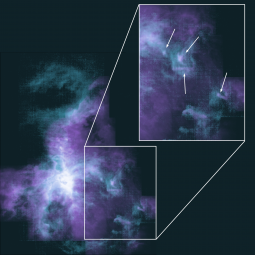By Cornelia Pabst, Javier Goicoechea, and Joan Schmelz
Paper:
Expanding bubbles in Orion A: [C II] observations of M 42, M 43, and NGC 1977
Pabst, C. H. M., et al., 2020/07, A&A, 639A, A2.
In the iconic Orion Nebula, an enormous stellar wind is blowing away its natal molecular cloud, forming a ridge of dense material along the edge of the resulting bubble. New results reveal signs of star birth along the edges within tiny, compacted clouds and offer new insights into how the stars of today can affect the stars of the future.
The young massive stars in the central Trapezium Cluster of Orion have created a bubble of hot X-ray emitting plasma that is enveloped by a shell of neutral gas and dust. The gas is heated by stellar radiation and cools mainly through the fine-structure line of ionized carbon, [CII], at 158 µm. The molecular gas situated in the star-forming cloud behind the nebula emits mainly in low-lying CO rotational transitions, such as the CO(2-1) line at 1.3 mm. When observed at very high spectral resolution, the Doppler shift in those lines can be used to trace gas motions.
SOFIA mapped an area of about one square degree -- four times larger than the full moon -- in the [CII] line emission from the Orion Nebula. The observations revealed that the neutral shell of disrupted material is expanding at 13 km/s away from the background molecular cloud. The wind from the central massive star, Theta1 Orionis C, is dominating stellar feedback, the processes that regulate future star formation. Stars can disrupt the dense gas of their birth environment, thereby preventing stellar siblings from forming nearby. Shock waves induced by stellar winds and radiation can lead to the compression of gas to trigger formation of new stars. Initially it was unclear if the powerful wind would facilitate or hinder star formation as the compacted material was pushed to the bubble’s edges.
The SOFIA observations were complemented by CO(2-1) velocity-resolved maps taken with the IRAM 30-meter radio telescope in Spain. The absence of large-scale CO(2-1) emission from the shell implies that this [CII]-emitting gas is “CO-dark,” but not necessarily 100% atomic since molecules may still survive or reform in this harsh environment. Indeed, the CO(2-1) results reveal several small -- about 10,000 astronomical units in size -- globules of dense molecular gas along the edges of the neutral expanding shell. This unexpected result may provide the first clue of triggered star formation in Orion.
While most of the material in the massive neutral shell will be lost to future star formation, the molecular globules may provide conditions suitable for the birth of new low-mass stars. In fact, one of the globules coincides with a known protostar. The masses of the globules, derived from the CO(2-1) lines, however, are only one solar mass or less, much lower than the mass needed to trigger their gravitational collapse. The analysis indicates that the shell surrounding the Orion Nebula will most likely not form new stars, but different outcomes may result is other star-forming regions with varying circumstances.
The [CII] line proves to be an ideal means for the study of stellar feedback in a wide range of conditions. Together with CO line observations, the complex interplay between neutral atomic and molecular gas under the influence of massive stellar winds and radiation can be explored. Wide-field mapping at high spectral resolution, such as provided by SOFIA and the IRAM 30-meter telescope, is required.
